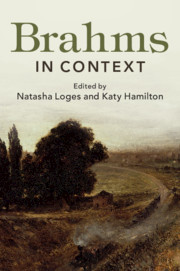Book contents
- Brahms in Context
- Brahms in Context
- Copyright page
- Dedication
- Contents
- Illustrations
- Music Examples
- Notes on Contributors
- Preface
- Abbreviations
- Part I Personality, People and Places
- Part II Identities, Environments and Influences
- Chapter 8 Finances
- Chapter 9 As Pianist
- Chapter 10 As Conductor
- Chapter 11 As Arranger
- Chapter 12 As Editor
- Chapter 13 As Teacher
- Chapter 14 Private Music-Making
- Chapter 15 Concert Life
- Chapter 16 Genre
- Chapter 17 Folk Music
- Chapter 18 Early Music
- Part III Performance and Publishing
- Part IV Society and Culture
- Part V Reception and Legacy
- Further Reading
- Index
- References
Chapter 13 - As Teacher
from Part II - Identities, Environments and Influences
Published online by Cambridge University Press: 15 May 2019
- Brahms in Context
- Brahms in Context
- Copyright page
- Dedication
- Contents
- Illustrations
- Music Examples
- Notes on Contributors
- Preface
- Abbreviations
- Part I Personality, People and Places
- Part II Identities, Environments and Influences
- Chapter 8 Finances
- Chapter 9 As Pianist
- Chapter 10 As Conductor
- Chapter 11 As Arranger
- Chapter 12 As Editor
- Chapter 13 As Teacher
- Chapter 14 Private Music-Making
- Chapter 15 Concert Life
- Chapter 16 Genre
- Chapter 17 Folk Music
- Chapter 18 Early Music
- Part III Performance and Publishing
- Part IV Society and Culture
- Part V Reception and Legacy
- Further Reading
- Index
- References
Summary
Brahms never studied at a music conservatory, nor did he ever teach at one. However, in private, individually negotiated settings, he was active as a teacher throughout his musical life in many ways. From his youth onwards, he gave piano lessons and sporadic theory lessons [see Ch. 1 ‘Childhood in Hamburg’]; later, he acted as occasional adviser to younger composers on many occasions, and even took on some regular students.
The young Brahms studied piano with Otto Cossel from 1840, changing to Eduard Marxsen in 1843, who also subsequently gave him composition lessons. At the age of fourteen at the latest, he began to give piano lessons himself, initially for free as a favour but soon in order to earn an income [see Ch. 8 ‘Finances’]. The few surviving statements of four of his students reveal that in these years he neither enjoyed teaching, nor was he particularly good at it.
- Type
- Chapter
- Information
- Brahms in Context , pp. 123 - 129Publisher: Cambridge University PressPrint publication year: 2019



